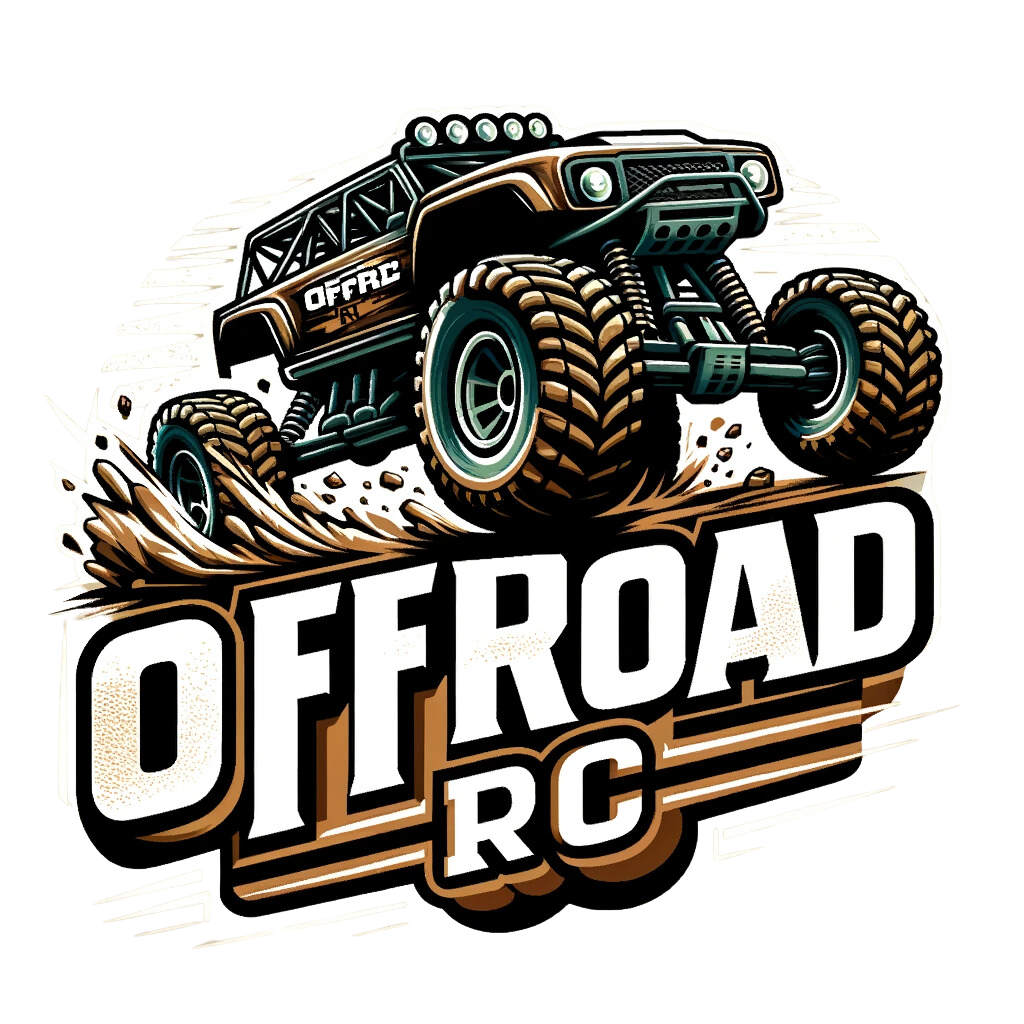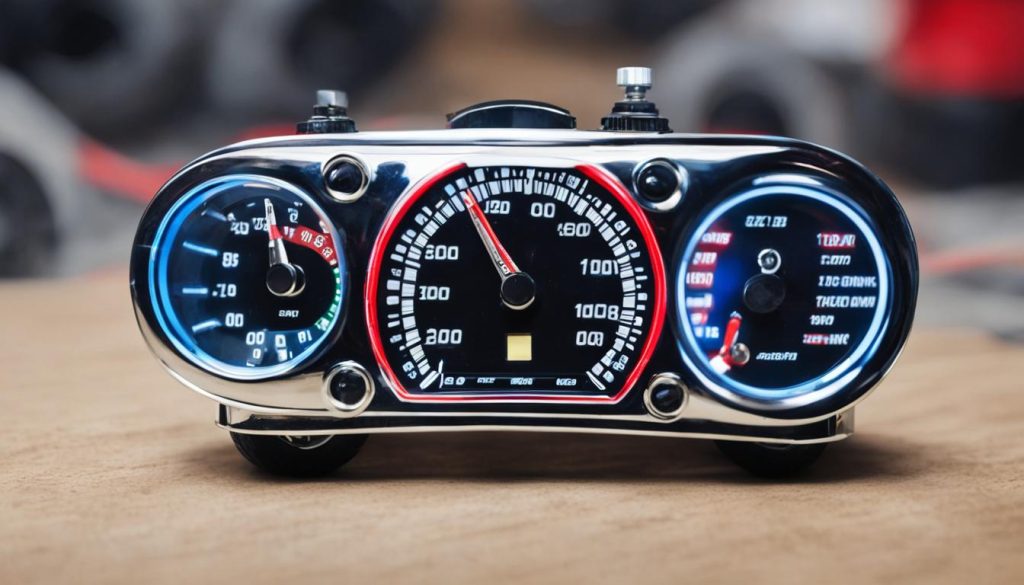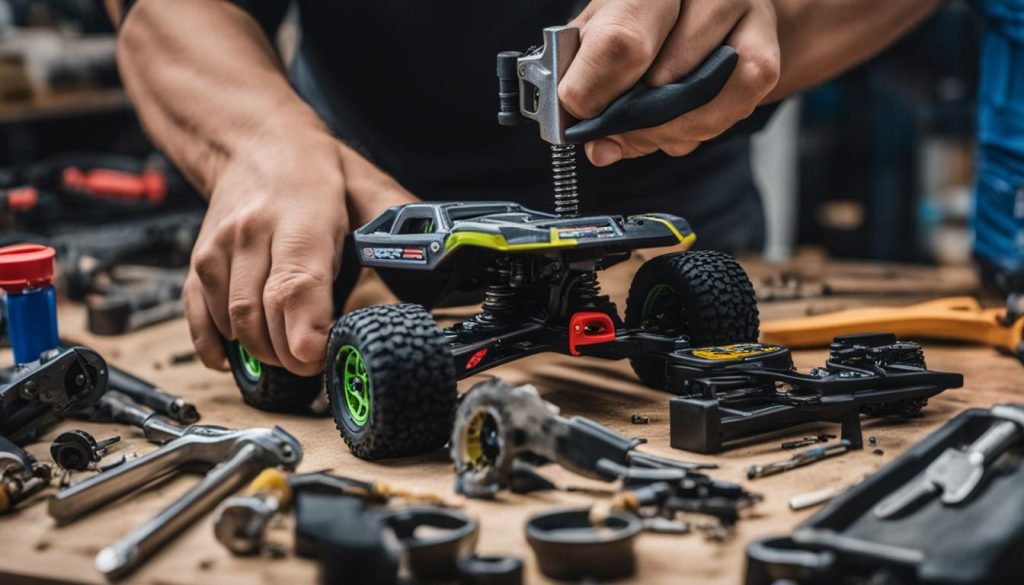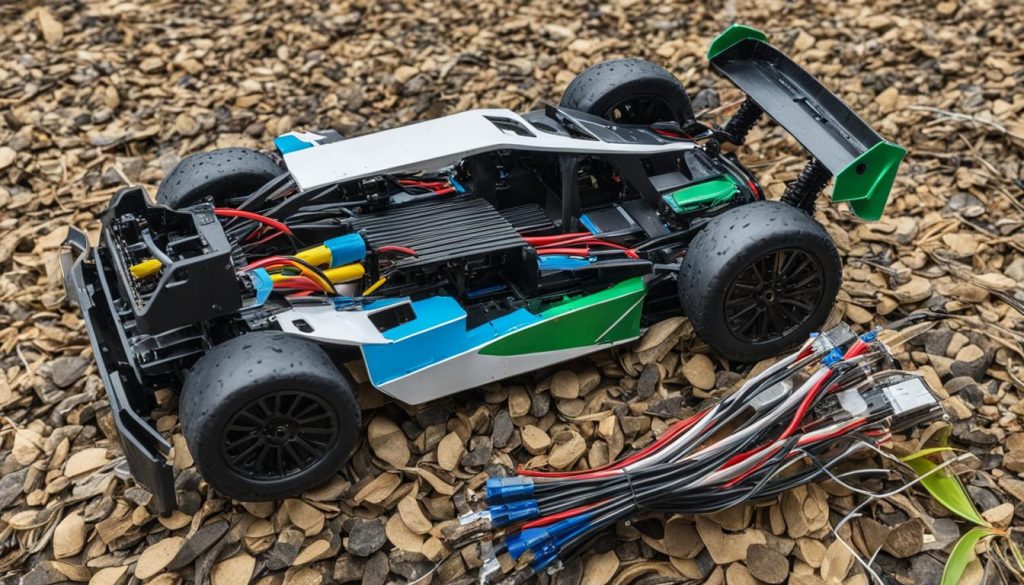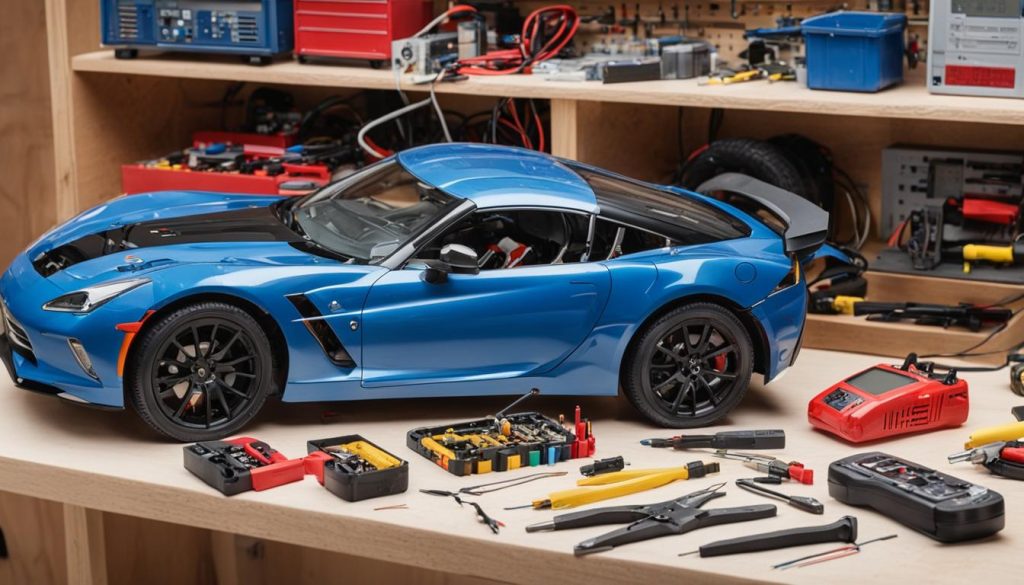Have you ever wondered how to change the speed of your RC car? Whether you want to increase or decrease its velocity, there are various methods and techniques that can help you achieve your desired speed. By implementing these tips and tricks, you’ll not only enhance your RC car’s performance but also have a more thrilling and enjoyable racing experience.
First and foremost, it’s important to understand that altering the speed of an RC car requires careful adjustments and modifications. From gear ratios and tire selection to weight reduction and battery upgrades, every aspect plays a role in determining the car’s speed and handling. Let’s explore some key strategies for achieving the desired speed modifications.
Key Takeaways:
- Changing the gear ratio can help you adjust the speed of your RC car.
- Using the appropriate tires for the racing surface can enhance traction and improve speed.
- Reducing the weight of the car through lightweight parts and batteries can increase its speed.
- Upgrading the battery, motor, and ESC can significantly improve the car’s speed and performance.
- Practicing and improving your driving skills can maximize the car’s overall speed and control.
Change the Gear Ratio
One of the quickest and easiest ways to change the speed of an RC car is by adjusting the gear ratio. By modifying the pinion gear and spur gear, you have the ability to alter the car’s performance in a significant way.
The pinion gear is the smaller gear that attaches to the motor, while the spur gear is the larger gear. By changing the size of these gears, you can manipulate how the power is transmitted from the motor to the wheels, ultimately affecting the car’s speed.
To increase the top speed of your RC car, you can increase the size of the pinion gear and decrease the size of the spur gear. This adjustment results in a higher gear ratio, which allows the car to achieve greater speeds. However, keep in mind that with this setup, the acceleration of the car will be slower.
On the other hand, if you prioritize quicker acceleration over top speed, you can decrease the size of the pinion gear and increase the size of the spur gear. This lowers the gear ratio, providing a boost in acceleration. However, the trade-off is a reduced top speed.
It’s crucial to find the right balance between gear ratios and ensure proper gear mesh, which refers to the correct alignment of the teeth on the pinion gear and spur gear. Improper gear mesh can cause inefficiencies, decreased performance, and potential damage to the gears.
By adjusting the gear ratio, you have the ability to fine-tune your RC car’s speed and acceleration to suit your preferences and race conditions. Experimenting with different gear combinations will allow you to find the optimal setup for your desired performance.
Use the Right Tires
The type of tires you use can greatly impact the speed and performance of your RC car. Choosing the right tires for the surface you are racing on is essential to achieve better traction and improve the car’s speed. Different tire treads and compounds are available, each suitable for specific surfaces and conditions.
For dry tarmac and road surfaces, slick tires are ideal. Their smooth surface provides minimal resistance, allowing your RC car to achieve higher speeds. Conversely, if you’re racing on grass or wet mud, full spike tires offer excellent grip and prevent slippage during acceleration and cornering.
When racing on carpet or astroturf, mini pin tires are highly effective. Their small, densely packed pins provide exceptional traction on these surfaces, allowing for better control and faster lap times. On the other hand, if you’re looking for versatility across different surfaces, mini spike tires offer a balanced grip suitable for various track conditions.
Remember to consider the compound of the tires as well. Softer compounds provide better grip but may wear out faster, while harder compounds offer durability but may compromise traction. Strike a balance between grip and longevity based on your racing preferences and track conditions.
By selecting the right tires for your RC car, you can optimize its grip, minimize slippage, and enhance overall performance. Ensure you have a variety of tire options to match different track surfaces and be prepared to adjust them based on changing conditions throughout your racing sessions.
Choosing the right tires is crucial for maximizing your RC car’s grip and speed. Different surfaces require specific tire characteristics to ensure optimal performance. Whether it’s slick tires for tarmac, mini pins for carpet, or full spikes for grass, picking the right tires will give you the edge in your RC car racing endeavors.
Reduce the Weight
Reducing the weight of your RC car is a key strategy to boost its speed and overall performance on the track. By optimizing the weight distribution and utilizing lightweight materials, you can enhance the agility and acceleration of your vehicle. Here are some effective ways to achieve weight reduction:
1. Replace Heavy Parts with Lightweight Alternatives
Consider swapping out heavy components of your RC car with lighter alternatives. Materials such as carbon fiber, graphite, or aluminum can significantly reduce the weight without compromising on strength or durability. Focus on replacing parts like chassis, suspension components, and body shells with lightweight options to improve the overall weight-to-power ratio.
2. Optimize Your RC Car’s Battery
The type of battery you use can have a significant impact on the weight and performance of your RC car. Consider upgrading to lighter and more efficient battery options like Li-Po (lithium polymer) batteries. These batteries offer a higher energy density, providing longer run times while reducing overall weight. Li-Po batteries are available in various sizes and configurations to match your RC car’s power requirements.
3. Fine-tune the Weight Distribution
Optimizing the weight distribution of your RC car can improve its balance and handling. By strategically positioning heavier components towards the center and lighter parts towards the extremities, you can achieve better traction and stability during high-speed maneuvers. Experiment with adjustments in battery placement, motor position, and additional counterweights to achieve the desired weight distribution.
4. Streamline Your RC Car’s Design
Aerodynamics play a crucial role in reducing drag and maximizing speed potential. Opt for sleek and low-profile body shells that minimize air resistance. Streamlined designs help your RC car cut through the air more efficiently, allowing for higher speeds. Consider body accessories like spoilers or diffusers to further enhance aerodynamic performance.
By reducing the weight of your RC car, you can improve its acceleration, top speed, and maneuverability on the track. However, it’s important to strike a balance between weight reduction and maintaining adequate traction and control. Experiment with different setups and perform regular tests to find the optimal weight configuration for your RC car’s performance.
Upgrade the Battery
Upgrading the battery of your RC car can have a significant impact on its speed and overall performance. By replacing older Ni-Mh or Ni-Cad batteries with modern Li-Po (Lithium Polymer) batteries, you can unlock a new level of power and efficiency. Li-Po batteries are known for their high energy density and lighter weight, making them perfect for enhancing the speed and agility of your RC car.
Swapping out your old battery for a Li-Po battery not only provides more power but also reduces the overall weight of the car. This reduction in weight allows for faster acceleration and higher top speeds, giving you the edge you need on the track. Additionally, Li-Po batteries are more efficient, providing longer run times and ensuring that you can enjoy extended racing sessions without interruption.
When upgrading the battery, it’s crucial to ensure compatibility with your RC car’s electronics and power system. Li-Po batteries operate at higher voltages and require specific charging and discharging methods to prevent damage and ensure safety. Always refer to the manufacturer’s guidelines and instructions to ensure a proper upgrade and avoid potential risks.
Benefits of Upgrading to Li-Po Batteries:
Here are some of the key benefits you can expect from upgrading to Li-Po batteries:
- Increased power output
- Reduced weight for improved acceleration
- Higher top speeds
- Longer run times
- More efficient energy utilization
| Li-Po Battery Upgrade | Benefits |
|---|---|
| Higher Power Output | Experience a significant increase in the power output of your RC car, allowing for faster acceleration and improved performance on the track. |
| Reduced Weight | Li-Po batteries are lighter than traditional Ni-Mh or Ni-Cad batteries, reducing the overall weight of your RC car and providing better handling and maneuverability. |
| Longer Run Times | Li-Po batteries offer extended run times compared to other battery types, allowing you to enjoy longer racing sessions without the need for frequent recharging. |
| Efficient Energy Utilization | Li-Po batteries are known for their high energy density, ensuring efficient energy utilization and maximizing the performance of your RC car. |
“Upgrade your RC car battery to a Li-Po battery and experience a whole new level of speed and performance. With increased power, reduced weight, and longer run times, you’ll dominate the track like never before!”
Upgrade the Motor and ESC
Another effective way to increase the speed of your RC car is by upgrading the motor and electronic speed controller (ESC). While most ready-to-run (RTR) cars come with budget brushed or brushless motor systems, opting for a high-performance brushless motor and ESC can provide significant speed gains for your RC car.
Why upgrade to a brushless motor? Unlike brushed motors, brushless motors are more efficient, which means they can deliver improved acceleration and higher top speeds. The absence of brushes in brushless motors also reduces friction, resulting in less heat generation and longer motor life.
Furthermore, brushless motors offer higher power outputs and can handle higher voltages, making them suitable for high-speed racing. These motors also provide smoother operation and precise control, enhancing your overall driving experience.
When upgrading your motor, it’s crucial to consider the compatibility of the motor and ESC with your RC car. Some popular and reliable brands for brushless motors and ESCs include:
- Traxxas
- Castle Creations
- Team Associated
- Hobbywing
- Novak
Each brand offers a range of motor and ESC options with different power ratings and compatibility with specific RC car models. It’s advisable to research and choose the motor and ESC combination that suits your performance needs and budget.
By upgrading your motor and ESC, you can unlock the full potential of your RC car, experiencing higher speeds and better overall performance.
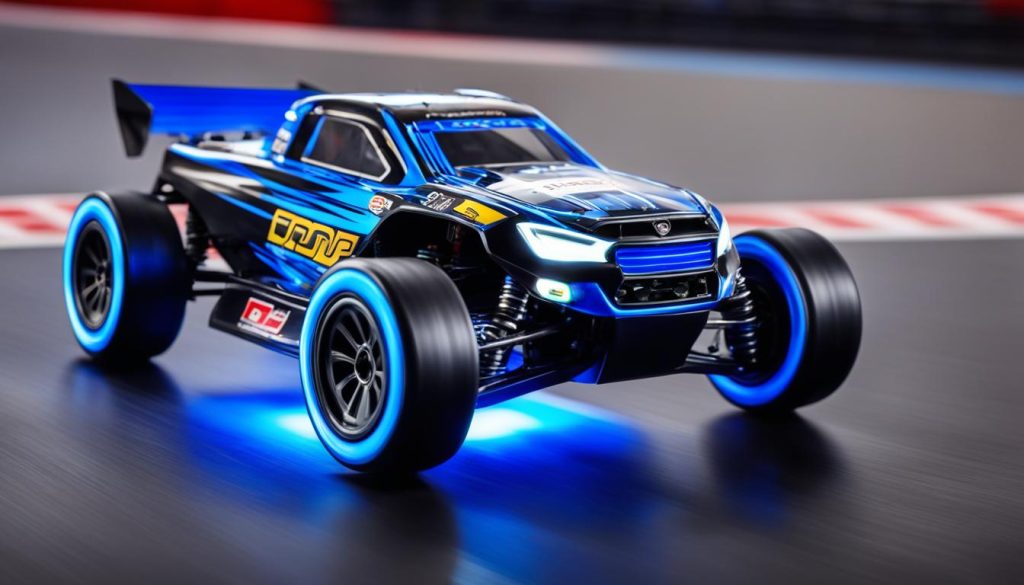
Benefits of Brushless Motor and ESC Upgrade:
| Benefits | Explanation |
|---|---|
| Improved acceleration | Brushless motors deliver faster and smoother acceleration, allowing your RC car to reach higher speeds quickly. |
| Higher top speeds | Due to their increased efficiency and power output, brushless motors enable your RC car to achieve higher top speeds, thrilling both racers and spectators. |
| Longer motor lifespan | Brushless motors generate less heat and experience reduced wear and tear compared to brushed motors, leading to a longer lifespan. |
| Precise control | Brushless motors provide smoother and finer control over your RC car’s speed, allowing you to navigate tight turns and obstacles with ease. |
| Less maintenance | With fewer moving parts and minimal brush maintenance required, brushless motors are generally easier to maintain compared to brushed motors. |
Use a More Aerodynamic Body Shell
When it comes to improving the top speed of your RC car, one key factor to consider is the aerodynamics of its body shell. By using a more aerodynamic design, you can reduce drag and enhance the car’s speed and performance.
An aerodynamic body shell features a sleek and streamlined shape that allows the car to cut through the air with minimal resistance. This reduction in drag enables the RC car to maintain higher speeds and achieve better overall performance on the racetrack.
While the difference in aerodynamics may not be noticeable during regular racing, it can make a significant impact in speed runs or when attempting to break speed records. To maximize the benefits of an aerodynamic body shell, it’s important to choose a design that is specifically tailored to your RC car’s make and model.
To visualize the effect of a more aerodynamic body shell, take a look at the image below:
As you can see, the streamlined shape of the car facilitates smooth airflow, resulting in reduced drag and increased speed.
When selecting an aerodynamic body shell for your RC car, consider factors such as the design, material, and compatibility. Many reputable RC car brands offer a range of body shells that have been optimized for aerodynamics. These shells are often made from lightweight and durable materials, such as polycarbonate, to enhance performance and durability.
Furthermore, some body shells also feature additional aerodynamic elements, such as spoilers or air vents, that further aid in reducing drag and improving performance.
Here’s a comparison table showcasing the benefits of using a more aerodynamic body shell:
| Without Aerodynamic Body Shell | With Aerodynamic Body Shell |
|---|---|
| Higher drag | Reduced drag |
| Slower top speed | Increased top speed |
| Less efficient airflow | Improved airflow |
| Reduced performance | Enhanced performance |
As you can see from the table, using a more aerodynamic body shell can significantly improve the speed and overall performance of your RC car.
It’s important to note that while an aerodynamic body shell can enhance speed, it may also affect handling. It’s recommended to fine-tune and adjust other components, such as suspension and weight distribution, to maintain a balance between speed and control.
In summary, by using a more aerodynamic body shell, you can reduce drag and improve the top speed of your RC car. Consider investing in a body shell that fits your car’s make and model, and take advantage of the benefits of reduced drag and enhanced performance.
Improve Driving Skills
While enhancing the car itself can improve speed, developing better driving skills is equally important. Skilled drivers can maximize the car’s performance, make smarter racing decisions, and navigate obstacles more effectively. Practicing different racing techniques, honing cornering skills, and learning how to control speed and acceleration can make a significant difference in overall performance.
Here are some RC car racing techniques and driving tips to help you become a better RC car driver:
- Master Cornering: Cornering plays a crucial role in racing. Learn how to take corners smoothly and efficiently to maintain speed. Practice controlling your RC car’s drift and finding the best racing line.
- Control Speed and Acceleration: Learning to modulate your car’s speed and acceleration is essential for maintaining control and maximizing performance. Experiment with different throttle inputs and braking techniques to improve your driving precision.
- Study Track Conditions: Analyze the track layout and surface conditions before each race. Different tracks may require different approaches and driving styles. Adjust your driving techniques accordingly to optimize speed and handling.
- Observe Experienced Drivers: Watch experienced RC car drivers in action. Observe their racing lines, cornering techniques, and overtaking strategies. You can learn a lot by studying their driving styles and incorporating their techniques into your own.
By continuously practicing and refining your driving skills, you can become a better RC car driver and improve your performance on the track.
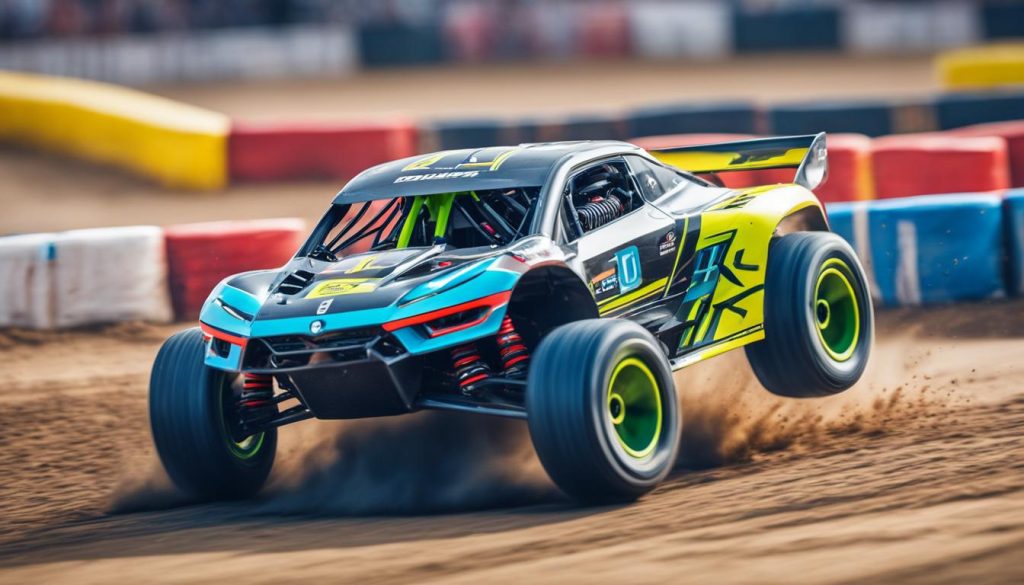
Remember, it’s not just about the car; it’s about the driver behind the wheel. Enhancing your driving skills will unlock the full potential of your RC car and make your racing experience more enjoyable and satisfying.
Adjust Handling and Performance
Fine-tuning the handling and performance of your RC car is crucial for achieving optimal speed and overall racing experience. By making strategic adjustments to various factors such as camber, roll center, suspension, and weight distribution, you can significantly impact how your car handles and performs on the track.
When it comes to handling tuning, one essential aspect to consider is the camber angle. Adjusting the camber refers to tilting the wheels inward or outward from the vertical axis. This adjustment affects the tire contact patch and influences the car’s grip and cornering capabilities.
Another important factor is the roll center, which refers to the virtual point around which the car’s body rolls when cornering. Adjusting the roll center can help control body roll and improve stability during turns, ultimately enhancing the car’s performance.
The suspension system plays a critical role in handling and performance as well. By fine-tuning factors such as shock absorber stiffness, spring rates, and damping settings, you can optimize the car’s responsiveness and minimize body movements, allowing for better control and faster lap times.
Weight distribution is another aspect that can significantly affect handling and performance. By redistributing weight from front to rear or side to side, you can improve traction and balance, thus enhancing the car’s ability to navigate corners and maintain stability at high speeds.
To optimize your car’s handling and performance, it’s essential to experiment and find the right setup that suits your driving style and track conditions. Fine-tuning these factors may require some trial and error, but once you discover the perfect balance, you’ll notice a significant improvement in speed, control, and overall racing experience.
“By adjusting camber, roll center, suspension, and weight distribution, you can optimize your RC car’s handling and performance, providing you with the competitive edge you need on the track.”
Remember, every adjustment you make should be incremental, and it’s crucial to keep track of the changes you’ve made and their effects on the car’s handling. This way, you can accurately assess the impact of each adjustment and make further fine-tuning as needed.
| Handling Factor | Description | Adjustment |
|---|---|---|
| Camber | Tilting wheels inward or outward from vertical axis | Adjust camber links or use camber plates |
| Roll Center | Virtual point around which the car’s body rolls | Adjust roll center by changing suspension geometry or roll center blocks |
| Suspension | System of springs, shocks, and damping settings | Adjust shock absorber stiffness, spring rates, and damping |
| Weight Distribution | How weight is distributed across the car | Redistribute weight front to rear or side to side |
By paying attention to these handling factors and making the necessary adjustments, you can optimize your RC car’s handling, responsiveness, and overall performance.
Maintain and Fine-Tune Regularly
Regular maintenance and fine-tuning are crucial for keeping your RC car in optimal condition. By conducting regular checks and making necessary adjustments, you can ensure that your car performs at its best. Here are some key areas to focus on for effective RC car maintenance and tuning:
1. Shocks
Inspect the shock absorbers of your RC car regularly to ensure they are in good working condition. Check for any leaks, damage, or signs of wear and tear. If necessary, replace worn-out shocks with new ones to maintain optimal suspension performance. Properly adjusted shocks can help absorb impacts and keep your car stable during high-speed runs.
2. Tires
Regularly check the condition of your RC car’s tires, including the tread and grip. Worn-out tires can affect your car’s acceleration, handling, and overall speed. If the tires are damaged or worn, consider replacing them with fresh ones that provide optimal traction for the specific track surface you’ll be racing on.
3. Gears
Inspect the gear system of your RC car to ensure smooth operation and proper gear mesh. Check for any signs of wear, damage, or misalignment. Adjust the gear ratio if needed to fine-tune your car’s speed and acceleration. Properly meshed gears will help maximize power transfer and improve overall performance.
4. Batteries
Regularly check the condition of your RC car’s batteries, whether they are Ni-Mh, Ni-Cad, or Li-Po. Ensure they are properly charged, balanced, and free from any damage. Replace old or worn-out batteries to maintain optimal power delivery and run times. Additionally, consider upgrading to higher-capacity or lighter Li-Po batteries for improved performance.
5. Lubrication
Properly lubricate the moving parts of your RC car, such as bearings, axles, and suspension components. This helps reduce friction, improve efficiency, and extend the lifespan of the parts. Use appropriate lubricants designed for RC cars and follow the manufacturer’s recommendations.
6. Repairs and Upgrades
Regularly assess your RC car for any damages or worn-out parts that require repair or replacement. Addressing issues promptly will help prevent further damage and maintain the car’s performance. Additionally, consider upgrading certain components like the motor, ESC, or chassis for enhanced speed and overall performance.
Remember, maintaining and fine-tuning your RC car regularly ensures that it continues to perform at its peak and extends its lifespan. By keeping a close eye on key components, conducting routine checks, and making necessary adjustments, you can optimize your car’s speed, handling, and overall racing experience.
Conclusion
In summary, changing the speed of your RC car involves a combination of factors that can greatly impact its performance. By adjusting the gear ratio, using the right tires, reducing the weight, upgrading the battery, motor, and ESC, using a more aerodynamic body shell, improving your driving skills, and fine-tuning the handling and performance, you can maximize your RC car’s speed and enjoy an exhilarating racing experience.
It’s important to note that safety should always be a top priority when making modifications or upgrades to your RC car. Ensure that you follow manufacturer guidelines and consider the compatibility of the components you choose. Regular maintenance and fine-tuning are crucial to keeping your RC car in optimal condition for sustained speed and performance.
With the knowledge and techniques shared in this article, you now have a comprehensive understanding of how to change the speed of your RC car. Experiment with different adjustments and modifications to find the perfect setup that suits your preferences and the track conditions. Embrace the thrill of high-speed racing while always prioritizing safety and responsible driving. Happy racing!
FAQ
How do you change the speed of an RC car?
There are various methods and techniques to change the speed of an RC car. By adjusting the gear ratio, upgrading the battery and motor, using the right tires, reducing the weight, improving driving skills, and fine-tuning the car’s performance, you can alter its speed and have a more enjoyable racing experience.
How can I change the gear ratio of an RC car?
To change the gear ratio of an RC car, you can adjust the pinion gear (the smaller gear on the motor) or the spur gear (the larger gear). Increasing the pinion gear size and decreasing the spur gear size will result in a higher top speed but slower acceleration. Conversely, decreasing the pinion gear size and increasing the spur gear size will provide quicker acceleration at the expense of top speed.
What tires should I use to improve the speed of my RC car?
The choice of tires depends on the racing surface. Slick tires are ideal for dry tarmac and road surfaces, while full spikes work well on grass and wet mud. Mini pins are effective on carpet and astroturf, while mini spikes offer a good all-around grip. Choosing the right tires for the surface you are racing on will provide better traction and improve the car’s speed.
How can I reduce the weight of my RC car?
To reduce the weight of an RC car, you can replace heavy parts with lightweight alternatives such as carbon, graphite, or aluminum. Additionally, using lighter batteries like Li-Po instead of Ni-Mh or Ni-Cad can also reduce weight and improve performance. However, it’s important to keep in mind that reducing weight may affect traction and cornering, so adjustments might be needed to maintain balance and control.
Can upgrading the battery improve the speed of an RC car?
Yes, upgrading the battery of an RC car can significantly improve its speed and performance. Swapping out older Ni-Mh or Ni-Cad batteries with modern Li-Po batteries can provide more power and reduce weight, resulting in faster acceleration and higher top speed. Li-Po batteries are also more efficient and have longer run times.
How can I upgrade the motor and ESC of my RC car?
By upgrading the motor and electronic speed controller (ESC) of an RC car, you can experience significant speed gains. Most ready-to-run (RTR) cars come with budget brushed or brushless motor systems, but upgrading to a high-performance brushless motor and ESC can provide improved acceleration and higher top speeds. The choice of motor and ESC depends on personal preferences and budget.
Does the body shell of an RC car affect its speed?
Yes, using a more aerodynamic body shell can help improve the top speed of an RC car. A sleek and streamlined body shape reduces drag, allowing the car to slice through the air more efficiently. While the difference may not be noticeable in regular racing, it can make a small but significant improvement, especially in speed runs or attempting to break speed records.
How can I improve my driving skills to increase the speed of my RC car?
Improving your driving skills is essential to maximize the performance of an RC car. Skilled drivers can make smarter racing decisions, navigate obstacles more effectively, and control speed and acceleration. Practicing different racing techniques, honing cornering skills, and learning how to handle the car can make a significant difference in overall performance.
Can adjusting the handling and performance of an RC car improve its speed?
Yes, fine-tuning the handling and performance of an RC car can optimize its speed and overall racing experience. Adjusting various factors such as camber, roll center, suspension, and weight distribution can affect how the car handles and performs on the track. By finding the right setup that suits the driving style and track conditions, you can enhance the car’s speed and control.
How important is regular maintenance and fine-tuning for the speed of an RC car?
Regular maintenance and fine-tuning are essential for keeping an RC car in optimal condition. Checking and adjusting components like shocks, tires, gears, and batteries ensures that the car performs at its best. By keeping an eye on wear and tear, lubricating moving parts, and making necessary repairs or upgrades, you can maintain the car’s speed and performance over time.
